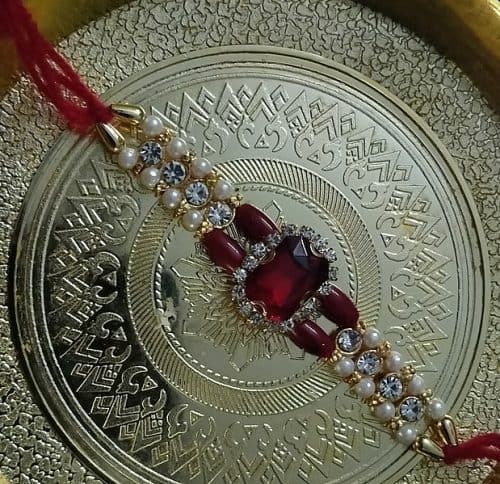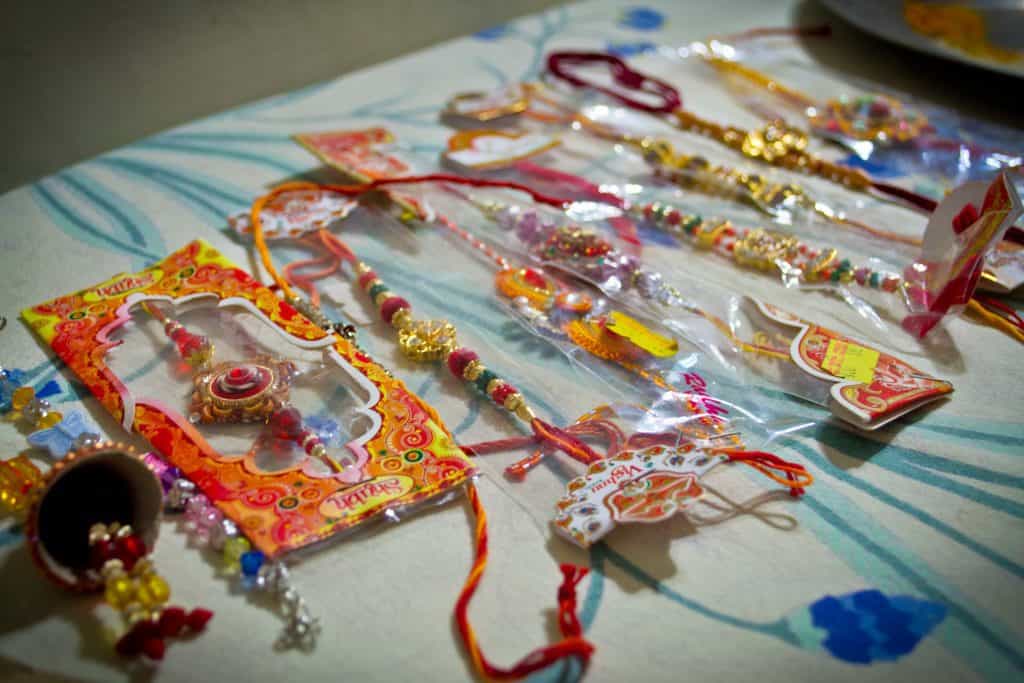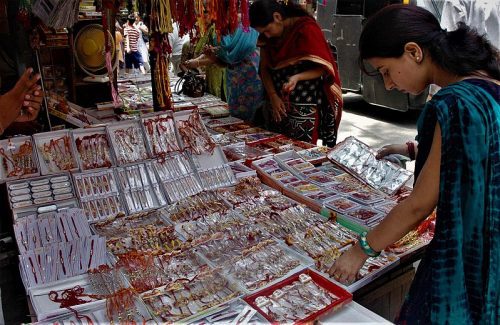The festival of Raksha Bandhan is not just about the ceremonial thread but the love, effort, and artistry that go into making each Rakhi. Understanding the intricate process behind Raksha Bandhan Rakhis – these beautiful creations and knowing where to find them adds a deeper appreciation to this beloved tradition.
This year, let’s celebrate the artisans who craft Raksha Bandhan Rakhis these symbols of love, making our bonds even more special.

Raksha Bandhan, commonly known as Rakhi, is a famous Hindu festival. Celebrated widely in India, it signifies brotherhood and affection among Indians, which is the true essence of Raksha Bandhan.
In Hinduism, Raksha Bandhan is a bond of protection symbolizing the purity and connection between siblings. This special festival usually takes place on the full moon day of the month of Shravan, according to the Hindu calendar. The festival highlights the extraordinary relationship between siblings and symbolizes brotherhood among Indians.
Process of Rakhi Making
The intricate process of Rakhi making combines traditional artistry with modern creativity, resulting in beautiful and meaningful pieces. Rakhi makers begin with design conceptualization, drawing inspiration from cultural symbols and current trends to create sketches and prototypes.
Design Conceptualization of Rakhi
Design conceptualization in Rakhi making is a meticulous process that blends tradition with modern creativity. Artisans draw inspiration from a variety of sources to create diverse designs. Traditional motifs such as peacocks, gods, and other cultural symbols are popular, reflecting India’s rich heritage.
Simultaneously, contemporary themes like superheroes and personalized initials cater to current trends and customer preferences, ensuring broad appeal. Artisans often turn to traditional art forms, religious iconography, and popular culture for their design inspiration, making each Rakhi both significant and attractive.
The process begins with sketching initial ideas. Artisans translate their creative visions onto paper, developing blueprints that detail the intricate patterns and overall look of the Rakhi. These sketches are essential as they guide the subsequent steps. Once the designs are sketched, prototypes are created to bring these ideas to life.
This phase is critical for experimenting with various materials and techniques, ensuring the final product is both aesthetically pleasing and durable. The prototypes help artisans assess the practicality of their designs, allowing them to make necessary adjustments before final production.
Balancing aesthetics with durability is a key aspect of Rakhi design. Rakhis must withstand wear while maintaining their intricate and delicate designs. Through careful conceptualization, artisans achieve this balance, creating Rakhis that are not only visually stunning but also resilient.
Material Selection
Material selection in Rakhi making is a critical aspect that contributes significantly to the final product’s aesthetic and durability. The base of a Rakhi is typically made using threads such as silk, cotton, and nylon, each chosen for their strength, flexibility, and ability to hold intricate designs.
Silk threads offer a luxurious feel, while cotton provides softness and comfort, and nylon adds resilience. To enhance the richness of the Rakhis, artisans sometimes incorporate fabrics like velvet and satin, which add a touch of opulence and elegance.
Decorative elements play a pivotal role in the visual appeal of Rakhis. Artisans meticulously select and use a variety of adornments, including beads, sequins, pearls, and stones. These elements are chosen not only for their beauty but also for their ability to complement and enhance the base materials.
Beads and sequins add sparkle and colour, while pearls and stones bring in a classic, sophisticated look. In response to growing environmental awareness, eco-friendly materials like clay and jute are also being used. These sustainable options provide a unique texture and appearance, making each Rakhi distinct.
Handcrafting
The handcrafting of Rakhis is a meticulous process that showcases the artisans‘ skill and creativity. The threadwork is the foundation, where skilled artisans twist, braid, and weave threads to form the base. This step involves intricate knotting and pattern-making, ensuring that the base is both sturdy and visually appealing.

Once the base is prepared, the embellishment phase begins. Decorative elements such as beads, sequins, and pearls are carefully sewn or glued onto the base. This requires precision and creativity, as each bead or sequin is strategically placed to enhance the overall design. The placement of these elements is crucial to bringing the design to life, adding colour, texture, and sparkle.
The final touches add a layer of elegance and charm to the Rakhis. Tassels, fringes, or tiny charms are added, completing the look and making each Rakhi unique. These final elements enhance the aesthetic appeal and add a sense of completeness to the design, ensuring that each Rakhi is a beautiful and meaningful symbol of love and protection.
Famous Markets to Purchase Rakhi
When it comes to purchasing Rakhis, local markets across India offer a vibrant and diverse selection, catering to various tastes and preferences. Chandni Chowk in Delhi is a prime example of a bustling hub for traditional Rakhis. This market is renowned for its vast array of designs, ranging from simple thread Rakhis to elaborate ones adorned with intricate embellishments. Similarly, Crawford Market in Mumbai is famous for its wide variety and affordability. This market caters to a broad spectrum of tastes, offering everything from minimalist designs to ornate creations. Also famous for its jewellery and craft items, Johari Bazaar offers a splendid selection of Rakhis, often featuring intricate designs and traditional motifs that highlight Rajasthani craftsmanship.
Rakhis can be purchased in various bustling markets, where the vibrant festival spirit comes alive with the plethora of designs and colours on display.
Raksha Bandhan Rakhis: Distinctive Designs Across Indian States, Where to Buy
Raksha Bandhan Rakhis, with their unique designs and cultural symbolism, are handcrafted in various parts of India. Here’s a deeper look at where these Rakhis are made, the intricate processes behind their creation, and the markets where they can be purchased.
Rajasthan: The Traditional Rakhi
In Rajasthan, traditional Rakhis are crafted using vibrant threads, beads, mirrors, and intricate embroidery. Artisans in cities like Jaipur, Udaipur, and Jodhpur use traditional methods, including hand embroidery and mirror work, to create elaborate designs featuring peacocks, flowers, and other motifs. The use of silk threads and traditional Rajasthani motifs adds to the rich cultural tapestry of these Rakhis. Shoppers can find these beautiful Rakhis in markets such as Johari Bazaar in Jaipur, Hathi Pol Bazaar in Udaipur, and Clock Tower Market in Jodhpur.

Gujarat: The Beaded Rakhi
Gujarat’s Rakhis are known for their intricate beadwork. Crafted in places like Ahmedabad, Surat, and Rajkot, these Rakhis often incorporate vibrant beads, pearls, and stones. Artisans specialize in bead embroidery, creating patterns that reflect traditional Patola designs and other local textile motifs. These stunning Rakhis can be found in bustling markets like Law Garden Night Market in Ahmedabad, Rander Road Market in Surat, and Gundavadi Market in Rajkot.
Maharashtra: The Modest Rakhi
In Maharashtra, the focus is on simplicity and symbolism. Rakhis are often made with the sacred red and yellow ‘Kalava’ thread, sometimes adorned with small flowers or gold and silver embellishments. Artisans in Mumbai, Pune, and Nashik create these modest yet meaningful Rakhis, emphasizing purity and the sacred bond between siblings. Popular markets for purchasing these Rakhis include Crawford Market in Mumbai, Laxmi Road in Pune, and Saraf Bazaar in Nashik.
Punjab: The Golden Rakhi
Punjabi Rakhis are bold and opulent, often featuring gold and silver threads. Artisans in Amritsar, Ludhiana, and Patiala incorporate elements like coins, religious symbols, and Khanda motifs into their designs. These lavish Rakhis reflect the vibrant culture and heritage of Punjab. Hall Bazaar in Amritsar, Ghumar Mandi in Ludhiana, and Chhoti Baradari Market in Patiala are excellent places to find these eye-catching Rakhis.
West Bengal: The Artistic Rakhi
In West Bengal, Rakhis are a blend of art and culture. Crafted using ‘Shola’ (Indian cork) and traditional Bengali motifs, these Rakhis are made by artisans in Kolkata, Shantiniketan, and Bishnupur. The designs often include alpana patterns, fish, and conch shells, emphasizing the region’s rich artistic heritage. Shoppers can explore New Market in Kolkata, Shantiniketan Haat, and Bishnupur Market to find these unique Rakhis.
Uttar Pradesh: The Auspicious Rakhi
Uttar Pradesh’s Rakhis frequently feature religious symbols such as ‘Swastika’, ‘Om’, and deity images. Artisans in Varanasi, Lucknow, and Kanpur use silk threads, beads, and small idols or coins to create these spiritually significant Rakhis. The combination of traditional craftsmanship and spiritual symbolism makes these Rakhis special. They can be purchased in markets like Vishwanath Gali in Varanasi, Aminabad Market in Lucknow, and Naveen Market in Kanpur.
South India: The Minimalistic Rakhi
In South India, Rakhis are minimalistic and made from natural materials like cotton threads, sandalwood beads, and rudraksha. Artisans in Chennai, Bangalore, and Hyderabad focus on simplicity and elegance, emphasizing purity. These minimalist Rakhis can be found in popular markets such as T. Nagar in Chennai, Commercial Street in Bangalore, and Laad Bazaar in Hyderabad.
Raksha Bandhan Rakhis not only differ in design but also in their craftsmanship and the markets where they are sold. From the intricate beadwork of Gujarat to the opulent golden threads of Punjab, each state’s Rakhis reflect its cultural heritage and artistic traditions.
Legends on the origins of Raksha Bandhan
Several legends in Indian history describe the origins of this festival. One story from the Hindu epic Mahabharata relates to Hindu mythology. When Lord Krishna cut his finger, Draupadi tied a piece of cloth from her saree to stop the bleeding. This piece of cloth became a sacred thread symbolizing the true significance of Raksha Bandhan.
Another famous story involves King Bali and Goddess Lakshmi. The Demon King Mahabali, a devotee of Lord Vishnu, had Lord Vishnu protect his kingdom, requiring Vishnu to leave his place in Vaikuntam. Unable to stay apart from her husband, Goddess Lakshmi disguised herself as a Brahmin refugee woman and arrived at Mahabali’s castle. She tied a Rakhi on King Mahabali’s wrist on a full moon day, also known as Shravan Purnima.
After revealing her true identity, King Mahabali was so touched that he requested Lord Vishnu to return to Vaikuntam with Goddess Lakshmi. Touched by Lord Vishnu’s affection for his family, it became a tradition to invite sisters to tie the auspicious Rakhi thread on Shravan Purnima.
And so the festival of Raksha Bandhan continues to be celebrated with a spirit of love and togetherness. Each Rakhi, handcrafted with care, symbolizes the deep bond of love and protection between siblings, making the festival of Raksha Bandhan a truly special celebration across India.
Read more: Latest



